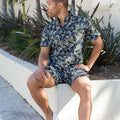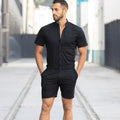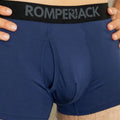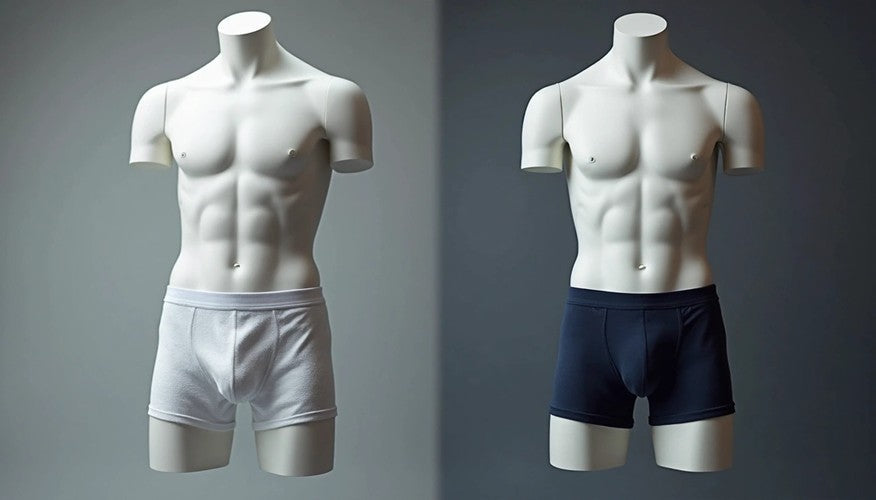Most guys automatically grab cotton when shopping for underwear. It's what we've always known, what our dads wore, and what seems like the safe choice. But here's the thing - cotton isn't always your best option for every situation or body type. The men's underwear market has exploded to over $29 billion as of 2024, with a steady 5.8% year-over-year growth. This shows just how important this seemingly simple garment really is in our daily comfort!
Cotton earned its reputation through its absorbent and breathable qualities, and there's no denying these benefits. However, through my research into modern underwear materials, I've discovered that newer alternatives can offer significant advantages that cotton simply can't match. The premium underwear segment is growing at an impressive 8.3% annually, with performance-oriented materials leading the charge at 12.1% growth. This shift isn't just about following trends - it's about addressing specific comfort needs that many men face.
Whether you're looking for the best men's underwear material for hot weather or trying to find the best underwear material for men who sweat, understanding fabric properties becomes crucial. Traditional boxers are usually made from pure cotton, but newer designs like boxer briefs often incorporate elastane to enhance stretch and support. These improvements make a real difference in how you feel throughout the day.
Don't settle for underwear that doesn't work for your lifestyle! This guide will walk you through why cotton isn't always your best friend and introduce you to superior alternatives that could completely change your underwear game. Ready to discover what you've been missing? Let's dive into the world of modern underwear materials that actually work with your body, not against it.
The legacy of cotton in men's underwear
Cotton has dominated men's underwear for generations, and this dominance isn't just coincidence. The story of how cotton became the default choice reveals centuries of textile evolution and cultural adoption. But as we look at why this natural fiber has remained so prevalent, it's worth asking: Does cotton truly deserve its throne as the best underwear material for men?
Why cotton became the default choice
Cotton's rise to underwear dominance started centuries ago, long before anyone thought about moisture-wicking or performance fabrics. Before the Industrial Revolution, most undergarments were made from linen or wool—materials that were either scratchy against sensitive skin or expensive to produce. Cotton changed everything when cultivation expanded and manufacturing techniques improved during the 18th and 19th centuries.
The revolutionized production drastically reduced the labor needed to separate cotton fibers from seeds. Cotton prices plummeted, making it the economical choice for undergarments. The material's versatility was another huge advantage—it could be woven into different densities and weights to suit various climate needs.
Major brands like Fruit of the Loom (founded in 1851) and Hanes (1901) built their empires on cotton undergarments, cementing their position as the default choice. Their widespread marketing campaigns throughout the mid-20th century convinced generations of men that cotton was synonymous with comfort and quality. This marketing was so effective that it shaped how we think about underwear even today.
Perceived benefits of cotton underwear
Cotton earned its reputation through several genuine advantages that appealed to consumers for generations:
· Breathability - Cotton naturally allows air to circulate, preventing trapped heat and moisture
· Hypoallergenic properties - For men with sensitive skin, cotton's natural fibers rarely cause allergic reactions
· Softness and comfort - Cotton develops a lived-in softness after multiple washes that many men appreciate
· Absorbency - Cotton can absorb up to 27 times its weight in water, which seemed ideal for managing sweat
· Affordability - Mass production techniques kept cotton underwear accessible at various price points
Cotton's reputation as a "natural" fiber also resonated with consumers increasingly concerned about synthetic materials against their skin. This perception of cotton as the "healthier" choice for the best type of underwear material for men persisted throughout the 20th century, even as synthetic alternatives began emerging.
Medical professionals often recommended cotton underwear for men with sensitive skin conditions, further reinforcing its status as the go-to choice. The ease of care—cotton's ability to withstand high washing temperatures—appealed to practical consumers seeking durability and convenience.
How cotton shaped consumer expectations
Cotton established the baseline for what men expected from their underwear. The standard features—elastic waistband, classic brief cut, white cotton fabric—became so ingrained in consumer consciousness that deviations from this norm were often viewed with skepticism.
For decades, men evaluated the best material for men's underwear against cotton's familiar properties. This historical dominance created a psychological comfort zone that made many men hesitant to try alternatives, regardless of potential benefits. Even today, without considering other options, approximately 65% of men automatically reach for cotton underwear.
Marketing campaigns throughout the 20th century reinforced these expectations. Iconic advertisements featuring muscular models in white cotton briefs established a visual shorthand for masculine underwear that persists in our cultural consciousness. These images solidified the idea that "real men" wear cotton underwear, making it challenging for innovative materials to gain widespread acceptance.
Here's what's interesting: while athletic apparel evolved rapidly with technical fabrics offering superior performance, underwear remained stubbornly traditional. The intimate nature of underwear created a resistance to change that other clothing categories didn't face. Many men maintained the attitude of "if it's not broken, don't fix it," even though cotton's limitations became increasingly apparent in our active, climate-controlled modern lifestyles.
This cultural attachment to cotton explains why many men still view it as the best underwear material for men who sweat, despite its significant moisture retention issues. Similarly, in hot weather regions, men continued to consider cotton the best men's underwear material for hot weather, unaware that modern alternatives could provide superior comfort.
The tide is finally turning as performance-focused brands like Romperjack introduce men to the benefits of advanced materials specifically engineered for intimate comfort. The expectations shaped by cotton's long dominance are being challenged by underwear that outperforms the traditional standard in nearly every meaningful category.
The hidden downsides of cotton underwear
Cotton has held its crown for decades, but let's be honest about what many guys discover the hard way - cotton underwear comes with some serious drawbacks that can make your day uncomfortable. These hidden issues help explain why cotton might not be the best underwear material for men in many everyday situations.
Retains moisture and sweat
Here's where cotton's famous absorbency actually works against you. Unlike modern performance fabrics, cotton it away from the skin. Think about it - once your cotton underwear gets wet from sweat, humidity, or any other source, it stays wet. Not exactly what you want down there!
This becomes a real problem during:
· Hot weather conditions when you're sweating more
· Long work shifts where you can't change
· After workouts or physical activity
That persistent dampness creates the perfect breeding ground for bacteria, leading to unpleasant odors, skin irritation, and sometimes genuine discomfort. Cotton's tendency to retain humidity can actually cause pain, especially in humid environments or during intense physical exercise. Nobody wants to deal with that!
Slow drying time
Cotton doesn't just hold moisture - it takes forever to dry compared to synthetic alternatives. This creates an extended period of dampness against sensitive areas. For guys looking for the best men's underwear material for hot weather or the best underwear material for men who sweat, this makes cotton a surprisingly poor choice.
The slow drying affects more than just comfort:
· Cotton underwear stays damp much longer after washing
· It needs more energy to dry completely in machines
· When you're traveling, wet cotton underwear might not dry overnight
I've heard from countless guys who found themselves stuck with damp cotton underwear hours after a workout or even just a walk in hot weather. Meanwhile, synthetic or other natural alternatives would have dried quickly and kept them comfortable.
Loses shape over time
Cotton fibers lack the natural elasticity found in modern fabric blends. Without elastane or similar stretchy materials, pure cotton underwear starts to sag and lose its supportive properties after multiple wears and washes. This is where cotton really shows its age.
You'll notice this deterioration in several frustrating ways:
· Waistbands that roll down or lose their grip
· Leg openings that stretch out and no longer contain properly
· Sagging in areas where you need support most
· Overall poor fit that has you constantly adjusting
Even high-quality cotton underwear typically has a shorter useful lifespan than modern alternatives when you consider fit and support. Cotton fibers deteriorate more quickly over time, resulting in thinning and progressive loss of shape. Not exactly the durability you want from your daily essentials.
Not ideal for high-movement activities
For active guys, cotton underwear presents some serious challenges. The lack of natural stretch fails to provide the snug fit and flexibility that modern textiles offer. This makes cotton a problematic choice for activities requiring unrestricted movement.
The combination of moisture retention and poor elasticity creates a perfect storm during physical activity:
1. Cotton absorbs sweat without wicking it away, creating chafing as wet fabric rubs against skin
2. Without stretch, cotton doesn't move with your body, causing uncomfortable bunching
3. The fabric's lack of flexibility restricts your range of motion during exercise
4. Once damp, cotton becomes heavier and may sag, requiring constant adjustment
Athletic apparel companies figured this out decades ago - that's why virtually no performance sportswear uses pure cotton. Yet many guys still choose cotton for the garment closest to their most sensitive areas. Seems backward, doesn't it?
Understanding these limitations helps explain why the best type of underwear material for men increasingly features advanced fabrics that address cotton's fundamental shortcomings. Your comfort deserves better than these daily frustrations!
Better alternatives: Modern underwear materials
Now that we've covered why cotton has its limitations, let's explore the exciting world of modern underwear materials that actually solve these problems. These innovative fabrics outperform traditional cotton in virtually every way that matters for your daily comfort.
Modal: Softness and breathability
Modal fabric feels incredibly soft against your skin—many guys describe it as having a silky texture that's perfect for sensitive skin. Made from beech tree pulp, modal combines the breathability of natural fibers with enhanced performance characteristics.
What makes modal stand out is its impressive moisture-wicking capability. It then cottons, drawing sweat away from your skin and allowing it to evaporate quickly. This keeps you dry and comfortable throughout the day, making it perhaps the absorbs up to 50% more moisturebest underwear material for men who sweat.
Modal underwear also maintains its shape remarkably well after multiple washes. Unlike cotton, which deteriorates quickly, modal fibers enhance both comfort and longevity. For those concerned about sustainability, modal offers an environmentally friendly option as it's derived from sustainably sourced beechwood trees, requiring less water and energy to produce compared to conventional cotton.
Bamboo: Eco-friendly and antibacterial
Bamboo fabric has become a standout choice for the best type of underwear material for men who care about both comfort and environmental impact. The production process for bamboo is notably eco-friendly—bamboo plants require minimal water, no pesticides, and produce more per square meter compared to cotton plants.
Here are the key advantages bamboo underwear offers:
· Natural antimicrobial properties that prevent odor and bacterial growth
· Superior moisture absorption and quick drying capabilities
· Exceptional breathability that keeps you cool in hot weather
· Hypoallergenic nature that minimizes skin irritation and allergic reactions
Bamboo's natural thermoregulating properties make it an excellent choice for year-round wear. The fabric keeps you cool in summer and warm in winter by adapting to your body temperature. Pretty impressive for a plant-based material!
Microfiber and synthetics: Performance and durability
Microfiber underwear represents a significant leap forward in men's comfort technology. This lightweight synthetic material combines polyester with similar synthetics like polyamides to create a fabric that's incredibly soft and durable.
For active men, microfiber's performance capabilities make it the best men's underwear material for hot weather. It wicks away moisture efficiently, keeping you dry even during intense physical activity. Additionally, microfiber dries significantly faster than cotton after washing, making it practical for travel or regular use.
Most importantly, microfiber's remarkable stretch and flexibility provide superior support without compromising comfort. It moves with your body, preventing the bunching and discomfort common with cotton underwear. This combination of comfort and functionality explains why microfiber is increasingly considered the best material for men's underwear for high-movement activities.
Tencel and Lyocell: Sustainable luxury
Tencel (a branded form of lyocell) represents perhaps the most sophisticated option for what is the best underwear material for men with discerning tastes. Created from wood cellulose, typically eucalyptus trees, Tencel boasts environmental credentials that set it apart from most fabrics.
The production process uses a closed-loop system that recycles water and solvents, minimizing waste and environmental impact. More than 99% of the solvents used are recovered and reused.
From a comfort perspective, Tencel offers incredible absorption properties—50% more than cotton—making it exceptionally breathable and ideal for activewear applications. Its silky texture creates a luxurious feel against the skin while its moisture-wicking properties keep you dry all day.
For those seeking the ultimate combination of performance, sustainability, and comfort, Tencel stands as a premium choice that delivers on all fronts. Remember, investing in quality underwear materials means investing in your daily comfort and confidence.
Choosing the best underwear material for your needs
Finding the right underwear material isn't a one-size-fits-all situation. Your lifestyle, activity level, and personal preferences all play a role in determining what works best for you. After researching countless fabric options and reading through customer experiences, I've found that different scenarios definitely call for specialized materials that address particular concerns.
Best material for men who sweat
Are you someone who perspires heavily throughout the day? The ideal underwear fabric needs to effectively manage moisture while preventing that dreaded odor buildup. Offer the best combination of support and sweat control for athletic activities and active lifestyles. These materials pull moisture away from the skin to the fabric's outer surface, where it can evaporate quickly.
MicroModal stands out as an exceptional choice for sweaty conditions because it pulls moisture away from your skin more effectively than cotton, helping prevent that uncomfortable clammy feeling. Its superior breathability and moisture management properties make it ideal for men who experience excessive perspiration throughout the day.
Concerned about odor alongside sweat? Look for underwear with antibacterial treatments. ExOfficio's Give-N-Go 2.0 boxer briefs, for instance, include an antibacterial finish specifically formulated to reduce odor. As one tester noted, "They definitely combat odor. I have worn these for years, and they have never let me down."
Best men's underwear material for hot weather
When temperatures rise, breathability becomes your best friend. Breathable mesh fabrics that wick moisture and dry quickly offer the best defense against heat-related discomfort. Materials like bamboo and other natural, breathable fibers promote optimal airflow during warmer days.
The exemplifies ideal hot-weather underwear, featuring a sport-mesh fabric blend of 90% nylon and 10% elastane that's exceptionally lightweight at just 1.76 ounces. These boxer briefs take only two and a half hours to fully air-dry, making them excellent for travel in hot climates.
For maximum ventilation, look for designs with breathable panels or mesh zones around areas that generate the most heat, such as the inner thighs and back. These strategic ventilation features allow heat to escape, keeping you cooler throughout the day.
Best type of underwear material for daily wear
For everyday comfort, you want softer fabrics with just enough elasticity to provide the optimal balance. Modal has emerged as a favorite for daily wear thanks to its silky-soft feel that's light and cool against the skin. Many testers report that their favorite modal boxer briefs "almost disappear" under their clothes.
Cotton blends with at least 90% cotton and some elastane (around 4-8%) offer excellent everyday comfort while maintaining shape better than pure cotton. Kirkland Signature briefs, for example, feature fabric that's "soft enough to not catch your leg hairs or irritate your skin, yet still elastic enough, especially around the thighs, to move with you".
What is the best underwear material for men overall?
Considering all factors—comfort, moisture management, durability, and versatility—MicroModal emerges as perhaps the best overall underwear material for men. Here's why it excels:
· Superior softness (three times softer than cotton)
· Excellent moisture-wicking properties
· Natural breathability for temperature regulation
· Resistance to shrinkage and pilling
· Eco-friendly production (when sourced from responsible manufacturers like Lenzing)
MicroModal effectively addresses cotton's fundamental shortcomings while providing exceptional comfort. It's worth noting that although the initial cost is higher than basic options, you're investing in superior all-day comfort, better durability, and reliable performance, particularly regarding breathability and moisture management.
The truly best underwear material depends on your individual priorities. If sustainability matters most to you, Tencel or bamboo might be preferable options. If maximum performance during intense activity is your focus, synthetic blends with specialized ventilation may serve you better. Remember, the best choice is the one that makes you feel comfortable and confident throughout your day!
Fit, function, and fabric: How they work together
Understanding how fabric properties affect your underwear's performance can make a huge difference in your daily comfort. The relationship between materials, design, and how everything feels on your body isn't just technical mumbo-jumbo—it's the key to finding underwear that actually works for you.
Why material affects fit and support
Different fabrics offer varying levels of stretch and support, which directly impacts how your underwear fits throughout the day. Materials like polyester and blends help regulate your body temperature, preventing that uncomfortable overheating that can ruin your comfort. Meanwhile, fabrics containing Lycra allow your underwear to move with your body's natural contours, giving you a snug fit without creating those annoying pressure points.
Synthetic fabrics excel at moisture-wicking capabilities that natural fibers simply can't match. This property matters more than you might think—damp underwear leads to chafing and discomfort during movement. Fabrics that maintain their shape despite sweat or constant movement provide consistent support all day long, making them excellent candidates for the best underwear material for men.
Consider how your underwear feels after a long day. Does it still fit the same way it did in the morning? Quality materials with proper stretch recover their shape, while inferior fabrics stretch out and lose their supportive properties.
The role of pouch design and stretch
The pouch design in men's underwear serves multiple important functions beyond basic coverage. It creates a dedicated space that prevents uncomfortable sticking or chafing—issues that plague traditional flat-front designs. A well-designed pouch keeps everything secure and positioned properly, eliminating friction during movement.
Pouches made with mesh or other breathable materials contribute to better hygiene by wicking sweat and drying quickly. Proper ventilation is essential, so pouch designs that consider your body's natural perspiration patterns help prevent odors and maintain comfort throughout extended wear.
Materials with adequate stretch, such as those containing Lycra or spandex, enable the pouch to maintain its supportive shape while accommodating movement. When looking for the best type of underwear for men, consider designs that incorporate both anatomical pouches and stretchy fabrics—this combination provides the support you need without restricting your movement.
How fabric impacts long-term comfort
The durability of your underwear directly relates to fabric quality, and this affects your comfort over time. High-quality materials resist stretching, shrinking, and fading better than cheaper alternatives, maintaining their shape even after numerous wash cycles.
The GSM (grams per square meter) of fabric affects both durability and comfort. Heavier fabrics typically last longer but might compromise breathability, while lighter fabrics offer better ventilation but may wear out faster. The best material for men's underwear often strikes a balance between weight, breathability, and longevity.
Remember, investing in quality fabric means your underwear will continue to fit and feel good months down the road. Cheap materials might seem like a bargain initially, but they often lose their shape and comfort properties quickly, requiring frequent replacement.
What to look for when buying modern underwear
Shopping for men's underwear has changed dramatically from the old days of grabbing a pack of cotton briefs off the shelf. With so many options available now, knowing what features actually matter can help you make choices that will keep you comfortable all day long.
Check the fabric blend and GSM
When you're shopping for modern underwear, pay attention to —this measures how dense the fabric is. Higher GSM means thicker, more durable fabric, while lower GSM indicates thinner, lighter material. For underwear, you want a balanced GSM that gives you both comfort and longevity
Don't overlook the fabric composition! Pure cotton underwear often lacks the elasticity you need, but adding just 8% Lycra creates superior comfort without compromising breathability. Look for blends containing 90% or higher natural fibers with elastane—these provide ideal stretch while maintaining that soft feel against sensitive skin.
Look for moisture-wicking and odor control
The best underwear material for men should actively fight moisture. Quality pull sweat away from your body to the fabric's surface where it can evaporate quickly. This prevents that uncomfortable dampness that leads to chafing and irritation.
Here's what to look for in moisture management:
· Antibacterial properties that reduce odor-causing bacteria
· Natural antimicrobial benefits like those found in bamboo materials
· Quick-dry technology that keeps you comfortable during long days
Understand your body type and activity level
Your lifestyle should guide your underwear choice. For active guys, performance-focused underwear with four-way stretch accommodates movement without restriction. If you sweat heavily, look for breathable panels in high-heat areas like the inner thighs.
Body shape affects fit preferences too—different styles provide varying levels of support based on your anatomy. Consider pouch design, which creates dedicated space preventing uncomfortable friction during movement. Remember, the right fit makes all the difference in your daily comfort!
Why Romperjack underwear is gaining popularity
Romperjack has gained traction by addressing specific underwear concerns that many brands overlook. Their designs emphasize breathability with fabrics that match your body's natural ventilation needs. The brand prioritizes moisture management—essential considering that only 7% of people regularly go commando.
Their waistband engineering demonstrates thoughtful design, with elastic and adjustable features allowing customized comfort throughout daily activities. For active lifestyles, their focus on moisture-wicking capabilities makes them particularly suitable for guys who need underwear that performs as hard as they do.
Don't be afraid to invest in quality underwear that addresses your specific needs. Your comfort is worth the extra consideration when choosing materials and features that work with your body, not against it.
Conclusion
Cotton's long-standing reputation as the go-to underwear material doesn't mean it's always your best choice. While cotton certainly has its place, its moisture retention, slow drying time, and tendency to lose shape make it less than ideal for many situations that modern guys face.
The alternatives we've explored clearly outperform traditional cotton in the areas that matter most. Modal delivers exceptional softness while actually wicking moisture away from your skin. Bamboo offers natural antibacterial properties that keep you fresh while being environmentally friendly. Microfiber excels for active lifestyles with superior performance and durability. Tencel provides sustainable luxury that feels amazing against your skin.
Here's what really matters: the right underwear material depends entirely on your specific needs. Heavy sweaters benefit from moisture-wicking fabrics like MicroModal or polyester blends. Hot climate dwellers need breathable mesh materials that promote airflow. For daily wear, cotton blends with elastane maintain shape while providing comfort.
Remember, material choice affects everything from fit to function. The right fabric works together with proper pouch design and appropriate stretch to create underwear that truly supports your body throughout the day. This harmony between materials and design ultimately determines how comfortable you feel.
Making the switch from traditional cotton might require some experimentation, but the rewards are substantial. Once you experience the superior comfort and performance of modern underwear materials, going back to basic cotton becomes nearly impossible. Your underwear represents the first layer of comfort you put on each day—why settle for anything less than what actually works for your lifestyle?
Don't be afraid to try different materials and styles to find what truly makes you feel comfortable and confident. The perfect underwear material for your needs is out there, and the improved comfort will definitely be worth the effort. Happy underwear hunting!
FAQs
Q1. What are the drawbacks of cotton underwear for men? Cotton underwear retains moisture, takes a long time to dry, loses shape over time, and is not ideal for high-movement activities. These issues can lead to discomfort, chafing, and potential bacterial growth.
Q2. What are some better alternatives to cotton for men's underwear? Some superior alternatives include modal for softness and breathability, bamboo for eco-friendliness and antibacterial properties, microfiber for performance and durability, and Tencel for sustainable luxury. These materials often outperform cotton in moisture-wicking, quick-drying, and shape retention.
Q3. How do I choose the best underwear material for my needs? Consider your lifestyle and specific requirements. For those who sweat a lot, moisture-wicking fabrics like MicroModal or polyester blends are ideal. For hot weather, look for breathable mesh materials. For daily wear, soft fabrics with some elasticity, like modal or cotton blends with elastane, provide a good balance of comfort and durability.
Q4. What features should I look for when buying modern men's underwear? Pay attention to the fabric blend and GSM (grams per square meter), look for moisture-wicking and odor control properties, consider your body type and activity level, and check for features like breathable panels and well-designed pouches. Brands like Romperjack are gaining popularity for addressing these specific concerns.
Q5. Is cotton still considered the best material for men's underwear? While cotton remains popular, it's no longer universally considered the best material for men's underwear. Modern alternatives like MicroModal, bamboo, and performance synthetics often provide superior moisture management, durability, and comfort. The best material depends on individual needs and preferences.







